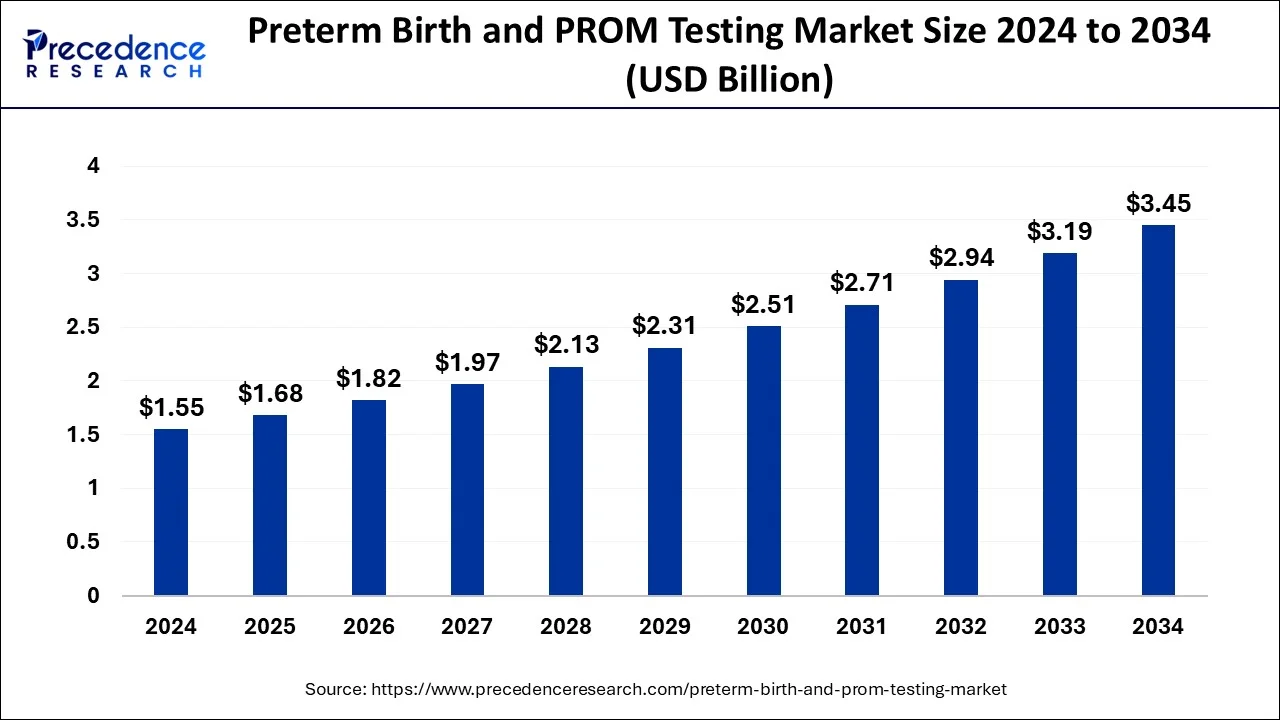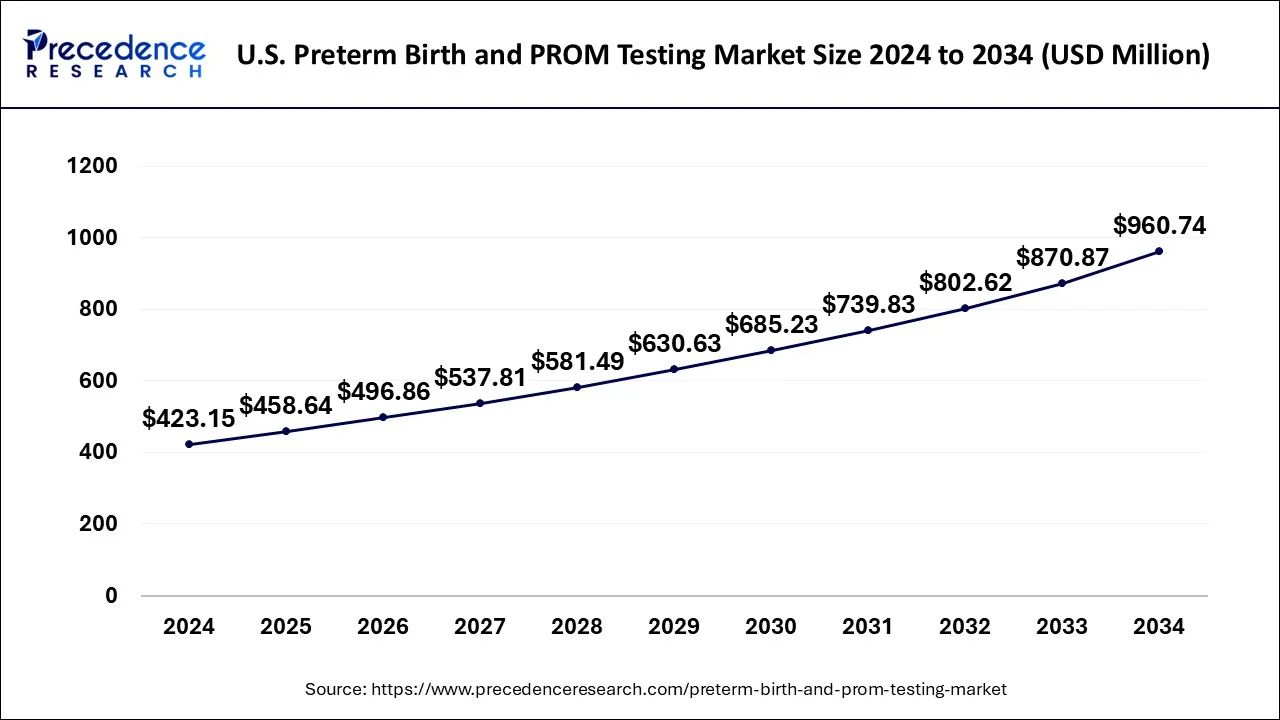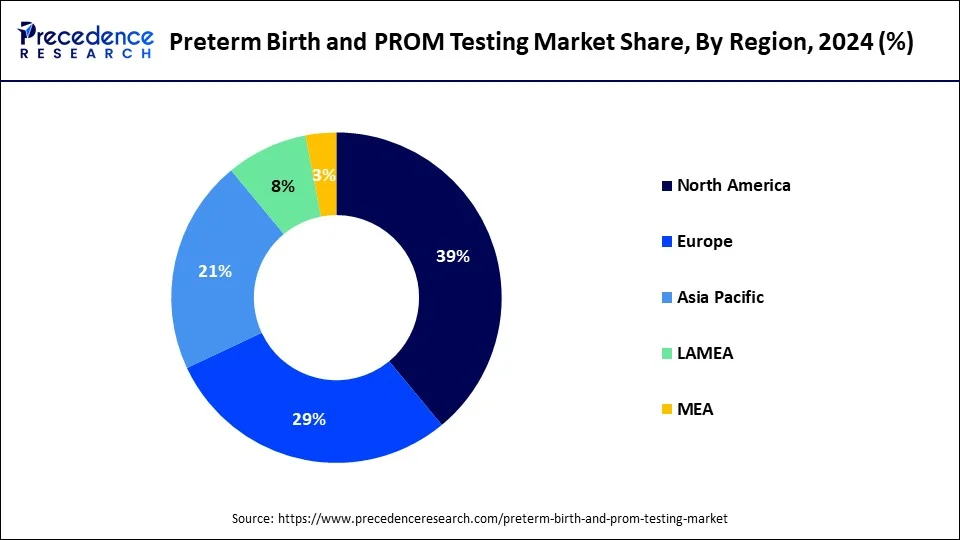August 2024
The global preterm birth and PROM testing market size was accounted for USD 1.55 billion in 2024, grew to USD 1.68 billion in 2025 and is predicted to surpass around USD 3.45 billion by 2034, representing a healthy CAGR of 8.34% between 2025 and 2034. The North America preterm birth and PROM testing market size was calculated at USD 600 million in 2024 and is expected to grow at a fastest CAGR of 8.53% during the forecast year.
The global preterm birth and PROM testing market size was estimated at USD 1.55 billion in 2024 and is anticipated to reach around USD 3.45 billion by 2034, expanding at a CAGR of 8.34% from 2025 to 2034.

Artificial intelligence (AI) can significantly impact the market by revolutionizing diagnostic testing. AI can be used to screen a large number of spontaneous preterm births based on clinical and ultrasonographic variables. AI and machine learning (ML) techniques including artificial neural networks and convolutional neural networks can aid in the early diagnosis of spontaneous preterm labor and birth. AI and ML result in improved efficiency and enhanced accuracy, sensitivity, and specificity. AI can also predict the outcomes of preterm birth and histologic chorioamnionitis in PROM. Additionally, AI and ML can aid in the effective diagnosis of imaging tests during pregnancy, enabling healthcare professionals to make timely decisions and reduce manual errors. However, the integration of AI and ML is still in its infancy requiring more research and generation of data.
The U.S. preterm birth and PROM testing market size was evaluated at USD 423.15 million in 2024 and is predicted to be worth around USD 960.74 million by 2034, rising at a CAGR of 8.62% from 2025 to 2034.

North America dominated the preterm birth and PROM market and accounted for the largest revenue share of 39% in 2024. This is attributed to the growing cases of preterm birth rate in U.S. It is reported that more than 370,000 babies were born prematurely in the U.S. in 2023. According to the Centers for Disease Control and Prevention, the early preterm rate was 2.76% and the late preterm rate was 7.65% in 2023 Around 17% of the preterm babies die due to low birth weight. The higher adoption of advanced technologies in the preterm birth and PROM testing has fueled the growth of the market in this region.The favorable reimbursement policies by the Centers for Medicare & Medicaid Services also propels market growth.

On the other hand, Asia Pacific is expected to be the most opportunistic market throughout the forecast period. According to the WHO, over 60% of the preterm birth cases occur in Africa and South Asia. The poor families in this developing region suffer the most. However, the growing awareness regarding the availability of PROM tests is positively impacting the market growth in the Asia Pacific region.
Preterm birth includes when a baby is born alive before 37 weeks of pregnancy are completed. Premature rupture of membranes (PROM) is a rupture of the amniotic sac before labor begins. When the PROM occurs before 37 weeks of gestation, the term preterm premature rupture of membranes (PPROM) is used. PROM occurs in about 8-10% of all pregnancies. At the same time, PPROM causes in around one-fourth to one-third of all preterm births. PROM can be diagnosed in many ways, including physical examination, microscopic analysis, vaginal fluid pH testing, diagnostic tests for amniotic fluid proteins, and dye test. Additional diagnostic tests may include obstetric ultrasound, urinalysis, and blood tests.
| Report Highlights | Details |
| Market Size in 2024 | USD 1.55 Billion |
| Market Size in 2025 | USD 1.68 Billion |
| Market Size by 2034 | USD 3.45 Billion |
| Growth Rate From 2025 to 2034 | CAGR of 8.34% |
| Base Year | 2024 |
| Forecast Period | 2025 to 2034 |
| Segments Covered | Test Type, End User |
| Regional Scope | North America, APAC, Europe, Latin America, MEAN, Rest of the World |
Favorable Government Policies
The increasing incidences of preterm births and PROM globally facilitate several government organizations to impose strict guidelines for early detection and screening of preterm births and PROM. The World Health Organization also makes efforts to increase the effectiveness of screening programs globally. The UK government has recently launched initiatives to ensure that all women have access to information and advice on pregnancy planning and preconception health. Government organizations provide funding for developing novel and innovative diagnostics for PROM. Additionally, they are on the verge of increasing awareness about PROM testing. Government-led insurance companies also offer favorable reimbursement policies to support patient’s healthcare expenses.
High Cost and Lack of Skilled Professionals
The major challenge of the preterm birth and PROM testing market is the high cost of PROM testing. The high cost of advanced PROM testing limits the affordability of several patients in low- and middle-income countries. Another major challenge is the lack of skilled professionals. The lack of skilled professionals, especially in developing and underdeveloped countries, restricts the market.
Point-of-Care Diagnostics
The growing demand for point-of-care (POC) diagnostics presents future preterm birth and PROM testing market growth opportunities. POC diagnostics are methods to test a medical condition at or near the patient. Several researchers are developing POC diagnostics for testing PROM. The ActimPROM test is the first FDA-approved reliable bedside test developed by Abbott Laboratories for quickly and easily detecting premature rupture of fetal membranes (PROM) in all patients. The demand for POC diagnostics increases due to improved patient outcomes and cost-effectiveness. They also save time for patients and help clinicians in effective decision-making. Thus, POC diagnostics have the potential to transform the healthcare sector by providing a path to increased access, cost, and treatment quality.
The ultrasound dominated the market with largest share in terms of revenue of the total market.
Ultrasound is the most common type of test conducted by the doctors to observe developing fetus. Ultrasound is a simple test where sound waves are used to produce images of the fetus inside the womb. It is considered to be the safest and painless test as no needles or injections and ionizing radiations are used. Therefore, the ultrasound is projected to retain its dominance throughout the forecast period.
On the other hand, the biomarker test is estimated to be the fastest growing during the forecast period. This is attributed to the accuracy of the biomarker test. A biomarker test is more accurate and reliable than the ultrasound testing. Moreover, biomarker tests can identify the patients that need urgent care. Further it is inexpensive, reliable, and usable at the POC (Point of Care). All these factors make the biomarker the most opportunistic segment during the forecast period.
The diagnostic laboratories dominated the market with around 45% share in terms of revenue of the total market.
The growing penetration of diagnostic labs all over the globe is positively contributing towards the growth of the preterm birth and PROM testing market. The rising awareness regarding PROM test coupled with rising disposable income and technological advancements in the medical test equipment has fostered the segment growth in the past few years. Moreover, cost-effectiveness has been achieved in the field of PROM testing that drives the growth of this segment.
The others segment includes healthcare units, and others point of care units. This segment is gaining rapid traction due to its increasing penetration across the globe. This segment is estimated to grow at a promising rate during the forecast period.
The market is moderately fragmented with the presence of several local companies. These market players are striving to gain higher market share by adopting strategies, such as investments, partnerships, and acquisitions & mergers. Companies are also spending on the development of improved and efficient preterm birth and PROM testing solutions. Moreover, they are also focusing on maintaining competitive pricing.
By Test Type
By End User
By Geography
For inquiries regarding discounts, bulk purchases, or customization requests, please contact us at sales@precedenceresearch.com
No cookie-cutter, only authentic analysis – take the 1st step to become a Precedence Research client
August 2024
July 2024
August 2024
April 2025